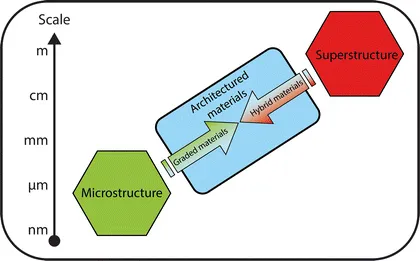
Materials Design Inspired by Nature
Function Through Inner Architecture
- English
- ePUB (mobile friendly)
- Available on iOS & Android
Materials Design Inspired by Nature
Function Through Inner Architecture
About this book
The inner architecture of a material can have an astonishing effect on its overall properties and is vital to understand when designing new materials. Nature is a master at designing hierarchical structures and so researchers are looking at biological examples for inspiration, specifically to understand how nature arranges the inner architectures for a particular function in order to apply these design principles into man-made materials.
Materials Design Inspired by Nature is the first book to address the relationship between the inner architecture of natural materials and their physical properties for materials design. The book explores examples from plants, the marine world, arthropods and bacteria, where the inner architecture is exploited to obtain specific mechanical, optical or magnetic properties along with how these design principles are used in man-made products. Details of the experimental methods used to investigate hierarchical structures are also given.
Written by leading experts in bio-inspired materials research, this is essential reading for anyone developing new materials.
Frequently asked questions
- Essential is ideal for learners and professionals who enjoy exploring a wide range of subjects. Access the Essential Library with 800,000+ trusted titles and best-sellers across business, personal growth, and the humanities. Includes unlimited reading time and Standard Read Aloud voice.
- Complete: Perfect for advanced learners and researchers needing full, unrestricted access. Unlock 1.4M+ books across hundreds of subjects, including academic and specialized titles. The Complete Plan also includes advanced features like Premium Read Aloud and Research Assistant.
Please note we cannot support devices running on iOS 13 and Android 7 or earlier. Learn more about using the app.
Information
The classical dichotomy between structure and materials to meet design requirements has led to separate routes, microstructure optimization and shape optimization. The increasing demand on a combination of properties in materials, and the required multi-functionality in present-day design can often no longer be met with ‘classical materials’. Architectured materials are a combination of material(s), shape and topology, at length scales comparable to the scale of the components. These materials offer an alternative strategy for ‘materials by design’. The occurrence of several length scales and the central role of geometry in this new class of materials, as well as the hierarchical structure often seen in biomaterials, suggest that bio-inspiration could be an interesting approach to the development of this innovative strategy.
1.1 Introduction: Materials, Structure and Between


| Conflicting requirements | Architectured materials |
| Combining tensile strength and flexural bendability | Cables |
| Plate combining lightness, flexural stiffness in one direction, and bendability in the other | Corrugated plates |
| Combining strength and damage tolerance with respect to surface defects | Soft layer on a hard substrate, such as a surface decarburised martensitic steel |
| Combining strength and corrosion resistance in a light alloy | Aluminium plates cladded with pure aluminium |
| Engineering objective | Architectured solutions |
| • Combining thermal conductivity and heat capacity for energy management | • Metallic wools or honeycomb filled with phase transformation materials |
| • Combining high thermal conductivity and low thermal expansion coefficient | • Mixture of metals and ceramics, copper/diamond, etc. |
| • Combining strength, thermal insulation and small gas permeability | • Multilayer polymer metal coatings |
| • Combining strength and toughness | • Phase transformation toughening ceramics, ceramic–polymer multilayers |
| • Combining deformability and magnetic strength, and possibly magnetostriction with large displacement | • Polymers reinforced with magnetic particles |
| • Thermally driven actuator | • Bimetallic strip |
| • Optical transparency, strength and safety in fracture | • Glass plates with polymer films |
| • Heat exchangers at minimum weight and resistant to oxidation | • Vapour deposited copper of a polymeric foam followed by cracking and surface treatment |
| • High strength cutting tool for fast machining | • Combination in a saw of a high conductivity copper core with a cermet blade |
| • Tiles for ablation and thermal protection for aerospace reservoirs | • Graded foams in a sandwich structure |
| • Diverter for fusion reactors extracting heat and resisting to plasma ablation | • Copper–tungsten multi-layers |
| • Shock protecting helmet with comfort | • Sandwich structure with a graded polyurethane foam |
1.2 Examples of Engineering Architectured Materials
Table of contents
- Cover
- Title
- Copyright
- Preface
- Contents
- Chapter 1 Architectured Materials: An Alternative to Microstructure Control for Structural Materials Design? A Possible Playground for Bio-inspiration?
- Chapter 2 Bone Structural Adaptation and Wolff’s Law
- Chapter 3 Understanding Hierarchy and Functions of Bone Using Scanning X-ray Scattering Methods
- Chapter 4 Advanced Transmission Electron Microscopy to Explore Early Stages of Bio(mimetic)mineralization
- Chapter 5 Collagen-based Materials for Tissue Repair, from Bio-inspired to Biomimetic
- Chapter 6 Materials Design Inspired by Tree and Wood Architecture
- Chapter 7 Raman Microscopy: Insights into the Chemistry and Structure of Biological Materials
- Chapter 8 The Mineralized Crustacean Cuticle: Hierarchical Structure and Mechanical Properties
- Chapter 9 Multi-scale Modelling of a Biological Material: The Arthropod Exoskeleton
- Chapter 10 Optical Biomimetics
- Chapter 11 Magnetic Nanoparticles in Bacteria
- Chapter 12 Hierarchical Protein Assemblies as a Basis for Materials
- Chapter 13 Anti-adhesive Surfaces in Plants and Their Biomimetic Potential
- Chapter 14 Bio-inspired Adhesive Surfaces: From Principles to Applications
- Chapter 15 Replicating Biological Design Principles in Synthetic Composites
- Chapter 16 Bio-inspired Self-healing Materials
- Subject Index